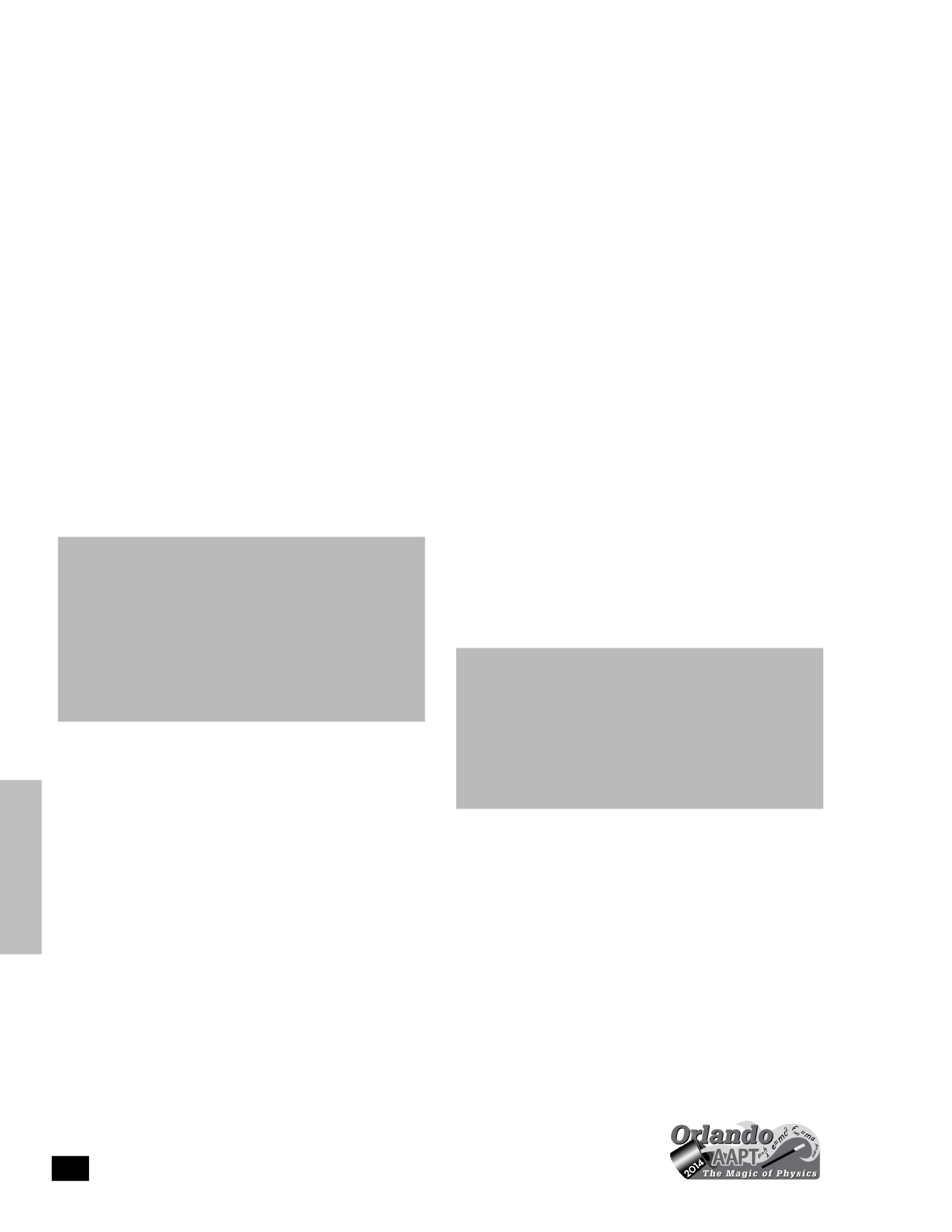
90
Tuesday afternoon
GC07:
1-1:10 p.m. Teaching Free-body Diagrams and
Geometrical Optics Using Interactive Whiteboards
Contributed – Tatiana A. Krivosheev, Clayton State University, Morrow,
GA 30260-0285;
We present our experience of developing the interactive whiteboard
flipcharts (IBWs) for the end-of-course exam review published by
Houghton Mifflin Harcourt. The supplement is designed for Texas
high school students and is built around the state performance
standards (TEKS). We focus on the advantages that the IBWs present
in the classroom compared to standard whiteboard teaching. Specifi-
cally, we discuss constructing a free-body diagram and building ray
diagrams for lenses and mirrors.
GC08:
1:10-1:20 p.m. 3D Printing for the Undergraduate
Lab
Contributed – Eric Ayars, California State University, Chico, Campus
Box 202, Chico, CA 95929-0202;
Three-D printing offers the potential to produce custom-designed
parts as easily as we now produce custom-designed paperwork.
That potential is starting to be met. Consumer-grade 3D printers
are available at reasonable prices, and the technology has reached a
point at which it can be cost-effective to print parts for laboratory and
student-project use. This talk will focus on the current state of 3D
printing technology, with examples of uses from the physics depart-
ment at CSU Chico. It will address the types of materials and shapes
that can be printed, the hardware and software required, advantages
and disadvantages of various 3D printer features, and some of the
costs and pitfalls one can expect to encounter.
Session GD: Classical Mechanics
in the Upper-Level Core: Frontiers
and the Classroom
Location: Salon 7
Sponsor: Committee on Physics in Undergraduate Education
Date: Tuesday, January 7
Time: 12–1:30 p.m.
Presider: Juan Burciaga
GD01:
12-12:30 p.m. Using Research to Investigate and
Enhance Learning in Upper-division Mechanics
Invited – Bradley Ambrose, Grand Valley State University, Department of
Physics, Allendale, MI 49401;
Researchers in physics education have repeatedly shown that
traditionally taught introductory courses have minimal effect on
the conceptual understanding, problem solving skills, and scientific
reasoning ability of most students’ including physics majors. Much of
that research suggests that lingering difficulties can adversely impact
student learning of more advanced material. Research in the context
of sophomore/junior level courses in intermediate mechanics has
been particularly fruitful in investigating student learning beyond the
introductory level. Such research has also been invaluable in guiding
the development and assessment of innovative instructional strategies
that can complement (and exceed the effectiveness of) traditional lec-
tures. This presentation will highlight results from research conducted
at Grand Valley State University, the University of Maine (by co-PI
Michael Wittmann) and pilot site institutions in the Intermediate
Mechanics Tutorials project. We present evidence of specific student
difficulties as well as examples of the use of guided inquiry in address-
ing these difficulties.
GD02:
12:30-1 p.m. Classical Mechanics Activities Across
the Paradigms in Physics
Invited – Elizabeth Gire, University of Memphis, 421 Manning Hall,
Memphis, TN 38152;
Corinne A Manogue, Oregon State University
The Paradigms in Physics courses at Oregon State University are well
known for blurring the traditional subdisciplines of physics. Topics in
classical mechanics in particular are distributed throughout the cur-
riculum and are often paired with topics from other subdisciplines.
These pairings are chosen to reinforce conceptual and mathematical
similarities among topics and to highlight important differences. The
Paradigms in Physics courses also, and perhaps more importantly,
feature a variety of active engagement instructional strategies. I will
discuss a few of the classical mechanics activities with emphasis on
their instructional goals and affordances, as well as the affordances of
sequencing with topics in other subdisciplines. I will also comment
on how these activities might be used in more traditionally structured
classical mechanics courses.
GD03:
1-1:30 p.m. Developing Practicing Physicists:
Transformations in Middle-Division Classical
Mechanics
Invited – Marcos Caballero, Michigan State University, East Lansing, MI
48824-1046;
Steven J. Pollock, University of Colorado Boulder
At most universities, upper-division physics majors are taught using
a traditional lecture approach that does not make use of instructional
techniques that have been found to improve many aspects of student
learning at the introductory level. Furthermore, while the scientific
community leverages computational modeling to understand many
physical systems, much of our physics majors’ experience solely
emphasizes analytical problem-solving. At the University of Colorado,
we have transformed our middle-division classical mechanics course
using the principles of active engagement and learning theory, guided
by the results of observations, interviews, and analysis of student
work. We have also begun to implement computational modeling.
We will outline these transformations including consensus learning
goals, clicker questions, tutorials, modified homeworks, and more, as
an example of what a transformed upper-division course might look
like. We are beginning to examine how our transformations impact
student learning and affect, and we will report on these results.
Session GE: Sustainability of
Teacher Preparation Programs
Location: Salon 8
Sponsor: Committee on Teacher Preparation
Date: Tuesday, January 7
Time: 12–1:30 p.m.
Presider: Steven Maier
GE01:
12-12:30 P.M. Sustainability Study of PhysTEC Sites
Invited – Monica Plisch, APS, 1 Physics Ellipse, College Park, MD
20740;
Rachel Scherr
The Physics Teacher Education Coalition (PhysTEC) project con-
ducted a study on the sustainability of teacher preparation programs
at sites that had previously received PhysTEC funding. A consultant
(Rachel Scherr) conducted site visits and/or telephone interviews
with eight institutions, and gathered qualitative and quantitative data.
Quantitative data included longitudinal data on program funding,
staffing, and physics education graduates. In addition, sites completed
a survey to document sustainability of individual key components, i.e.
whether each component was maintained, evolved, grown, reduced,
or eliminated. Case studies of individual institutions looked at the
institutional motivation for sustaining programs, the role of the
champion, and the mechanisms for sustaining program activities.
Results will be synthesized where possible to identify common themes
among sites.


